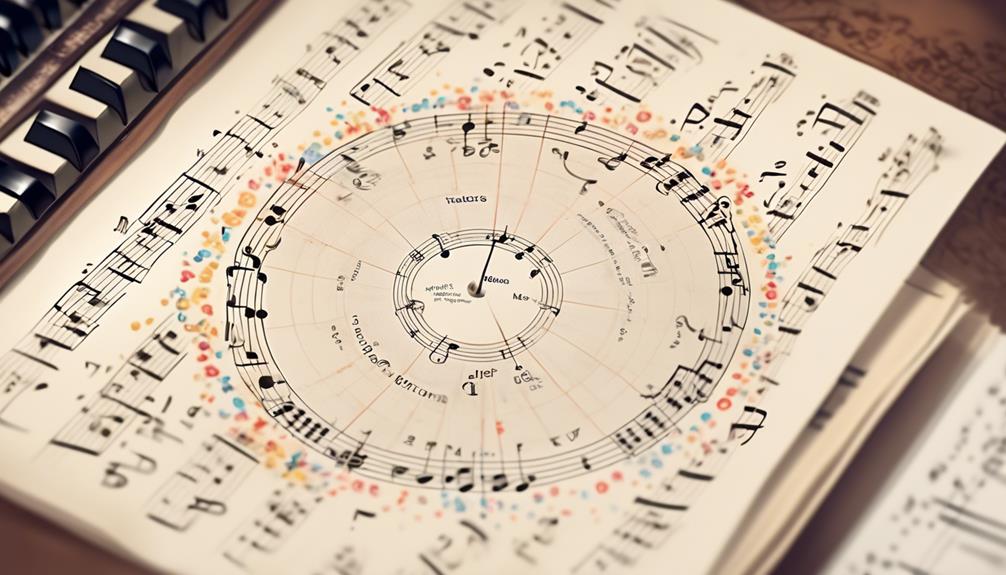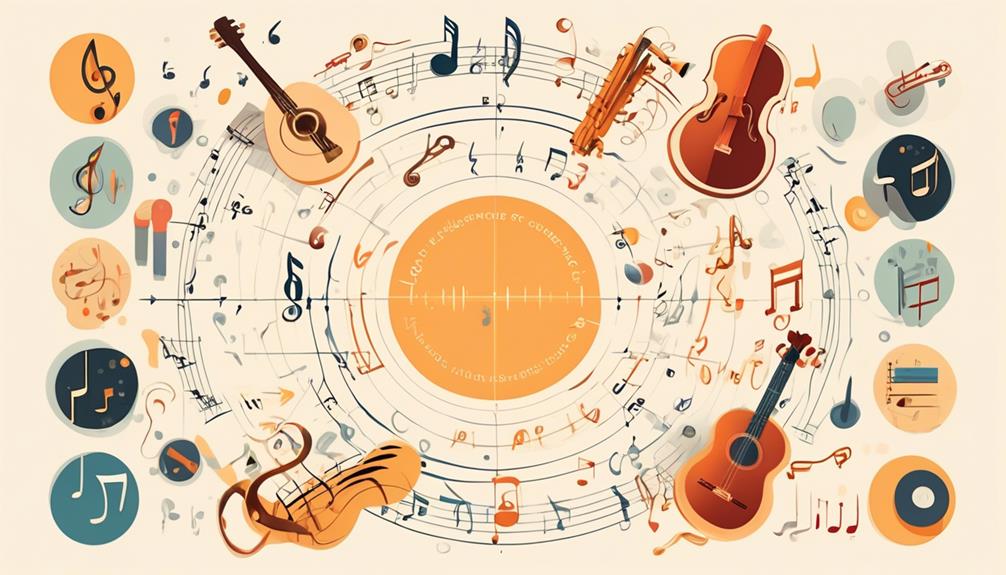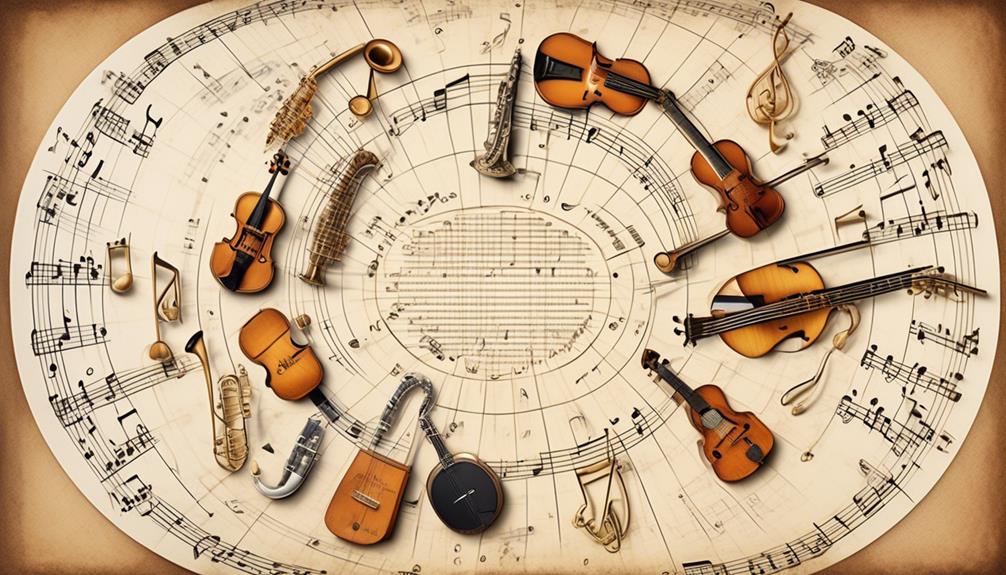-
1× £75.00 / Months and 10 Days free trial
-
1× £149.00
Subtotal: £149.00
Nearly 75% of aspiring musicians struggle with understanding key signatures, a cornerstone of music theory that you can’t afford to overlook. As you embark on your musical journey, grasping the concept of key signatures lays the foundation for interpreting and composing music with confidence.
You’re about to unlock the mysteries behind those seemingly random sharps and flats that map out the tonal landscape of a piece. By mastering key signatures, you’ll not only read music more fluently but also appreciate the intricate relationships between scales and harmonies.
Stick with this conversation to discover practical insights and tips that will transform your approach to music theory and enhance your skills as a musician.
Understanding key signatures is essential, as they provide the blueprint for the sharps or flats you’ll encounter throughout a musical piece, shaping its harmonic foundation. As a musician, you’ll find that key signatures are the roadmap, dictating tonality and guiding your melodic intuition, especially when applying key signatures in improvisation. Recognizing the right sharps or flats in a sequence is critical to maintaining the integrity of the scale and avoiding common key signature mistakes.
There are 15 major key signatures, with the key of C major serving as your neutral territory, devoid of sharps and flats. Mastering the sequence of sharps—F-C-G-D-A-E-B—using the mnemonic ‘Fast Cars Go Dangerously Around Every Bend,’ and the order of flats—B-E-A-D-G-C-F—remembered through ‘Father Charles Goes Down And Ends Battle,’ is fundamental. These sequences aren’t arbitrary; they follow a pattern that aligns with the circle of fifths, an innovative tool that visually organizes keys and highlights enharmonic equivalents.
Incorporating these structures into your practice not only prevents harmonic missteps but also empowers your improvisational skills, allowing for seamless transitions between keys and fostering a deeper understanding of musical relationships.
As you explore the Circle of Fifths, you’ll uncover how each major key signature is intricately connected by ascending or descending in intervals of a fifth.
This framework not only aids in recognizing the sharps and flats that define key signatures but also in transitioning smoothly between keys.
Grasping this concept is crucial for you to unlock the patterns inherent in minor key relationships, enhancing your overall musical fluency.
Dive into the circle of fifths to uncover the systematic layout of key signatures and their interconnectedness in music theory. This ingenious design maps out tonal relationships, providing essential insight for modulation techniques. As you progress clockwise, you’ll add sharps; counterclockwise introduces flats. Each step is a perfect fifth apart, revealing a structure integral to understanding key changes and harmonization.
Here’s a snapshot of the circle:
| Clockwise (Sharps) | Counterclockwise (Flats) |
|---|---|
| C Major (0) | C Major (0) |
| G Major (1) | F Major (1) |
| D Major (2) | B♭ Major (2) |
| A Major (3) | E♭ Major (3) |
| E Major (4) | A♭ Major (4) |
Grasping this circle equips you with a tool to navigate through key signatures and enrich your musical vocabulary.
Building on your grasp of the circle of fifths, let’s explore how to navigate major key signatures, ensuring you can accurately identify and apply them in musical contexts. By analyzing key changes, you grasp the harmonic structure essential for innovative music composition and performance.
Remember, each step clockwise adds a sharp, while each counterclockwise adds a flat. Sharps follow the order of F-C-G-D-A-E-B, a guide to quickly pinpointing key signatures. Conversely, flats align as B-E-A-D-G-C-F, simplifying the process of identifying enharmonic equivalents.
Applying these sequences allows you to deduce the key of a piece, whether it’s a sharp-laden E major or a flat-heavy Ab major. This knowledge is the bedrock for creating stability and logical progressions within your musical endeavors.
Understanding minor key signatures within the circle of fifths requires recognizing that each major key has a relative minor counterpart, located a minor third below its major sibling. Identifying relative minors is crucial for grasping the full spectrum of musical keys.
As you analyze the circle, you’ll notice that a shift clockwise introduces sharps, while a move counterclockwise integrates flats into the key signatures. These changes are just as relevant for minor keys as they’re for major ones.
The circle also helps you understand alterations unique to harmonic and melodic minor scales—variations that are vital for innovative composition and improvisation.
When comparing major and minor keys, it’s crucial to recognize how their distinct patterns of intervals shape the emotional tone of music. Major keys, configured with a series of whole and half steps that create a stable and often joyful sound, are the backbone of many compositions that aim to evoke feelings of happiness or victory. In contrast, minor keys follow a different sequence of intervals, giving rise to a sound that can be perceived as sad or contemplative.
The choice between major vs. minor chord progressions can dramatically alter the narrative of a melody. A shift from major to minor can plunge a previously bright melody into a state of sorrow or introspection. Similarly, transitioning from minor to major can lift a tune, infusing it with a sense of resolution or hope.
As you delve into music composition or analysis, understanding these tonalities becomes fundamental. The impact of key changes on melody isn’t just a technicality—it’s a powerful tool in the composer’s arsenal. It dictates the emotional journey that the listener will experience.
Therefore, mastering the nuances of these keys is essential for creating innovative and emotionally resonant music.


As you examine a piece of music, the key signature serves as your roadmap, indicating which sharps or flats consistently apply throughout.
For sharp keys, observe the progression of sharps and note that the key’s name is a semitone above the last sharp listed.
In contrast, when facing flat keys, you’ll find the key by looking at the second-to-last flat, a detail that simplifies navigation and ensures accurate performance.
To master sharp key signatures, you’ll need to recognize that each additional sharp follows a specific sequence, starting with F# and incrementally moving through the mnemonic ‘Fast Cars Go Dangerously Around Every Bend.’ Understanding this sequence is crucial:
Grasping the relationship between major and relative minor key signatures is foundational. For instance, G major’s relative minor is E minor. Both share the same sharp key signature.
The importance of understanding the order and placement of sharps in key signatures can’t be overstated—it’s essential for reading music and innovating within the tonal framework.
Having explored the sharp key signatures, let’s now shift our focus to the realm of flat keys, where a different pattern of intervals governs the landscape of musical notation. Unlike sharps, the order of flats follows B-E-A-D-G-C-F. This sequence is crucial when analyzing key signature patterns.
In flat keys, to unearth the major key, you look to the second-to-last flat. However, when exploring harmonic minor scales, a deeper understanding of the relationship between relative majors and minors becomes essential. The circle of fifths remains an innovative tool here, guiding you through key relationships with precision.
As you navigate flat key signatures, remember that each added flat represents a step counterclockwise in this circle, revealing the interconnectedness of keys in Western music theory.
Sharps and flats play critical roles in music by altering the pitch of notes to conform to the tonal framework established by a piece’s key signature. Understanding their roles is imperative to mastering music theory and enhancing your musical innovation. Let’s delve into the specifics:
Grasping the roles of accidentals in key signatures and the importance of understanding sharps and flats in music theory isn’t just academic—it’s the foundation of musical creativity and expression.


Understanding how to calculate key signatures is a fundamental skill that enables you to identify the number of sharps or flats in a key and comprehend their specific placement within the staff. This proficiency is crucial when exploring different key modes and identifying accidentals in key signatures. The order of sharps follows F-C-G-D-A-E-B, and for flats, it’s the reverse: B-E-A-D-G-C-F.
| Order of Sharps | Order of Flats |
|---|---|
| F | B |
| C | E |
| G | A |
| D | D |
To determine a sharp key signature, for example, look to the last sharp and move a half step up to find the key’s tonic. Conversely, for flat key signatures, the second-to-last flat tells you the major key.
Let’s dive deeper. The circle of fifths is an innovative tool for visualizing this process, displaying major keys in a circular layout that progresses by fifths. Each step clockwise adds a sharp, while each step counterclockwise adds a flat.
Now that you’re equipped with the essentials of calculating key signatures, let’s focus on honing your ability to quickly identify them in practice. Analyzing key signature patterns and practicing key signature recognition and notation are crucial skills for any musician.
Here are four key signature practice tips:
Incorporate these practices into your routine to deepen your proficiency with key signatures. As you do, you’ll find that your ability to interpret and notate music becomes increasingly intuitive.


Despite their crucial role in music notation, key signatures often fall prey to a host of misunderstandings that can confuse even experienced musicians. You might think you’ve got a handle on them, but common key signature misconceptions can trip you up, leading to common mistakes in identifying key signatures.
One prevalent error is the assumption that a key signature with sharps or flats always corresponds to major keys. However, each key signature also represents a relative minor key. For instance, the key signature with two sharps isn’t just D major, but also B minor. Recognizing this dual representation is essential for accurate interpretation.
Another mistake lies in the method of determining the key. While it’s true that for sharp key signatures you can find the major key by raising the last sharp by a half step, don’t forget that for flat key signatures, you look to the second-to-last flat—not the last one—to determine the major key.
Moreover, some may overlook the key of C major/A minor because it lacks sharps and flats. It’s a key signature in its own right, not a blank slate. Understanding these nuances is key to decoding music accurately and expressing its intended emotional and harmonic landscape.
Grasping the intricacies of key signatures not only rectifies common misconceptions but also empowers you to apply them effectively when composing your own music. Whether you’re creating an evocative score for a film or improvising in a jazz ensemble, understanding the foundations of key signatures is pivotal.
Here’s how you can harness them in your musical endeavors:
Consider key signatures as tools in your compositional toolbox. They’re not just rules to follow but opportunities for innovation, guiding you to communicate your artistic vision with precision and creativity.
You’ll master key signatures by memorizing the sharp and flat order. Use the Circle of Fifths to connect relative minors and innovate your approach to identifying keys quickly and accurately.
To identify a key signature, examine the sharps or flats and reference the circle of fifths. Understanding intervals helps; for sharps, the key’s a half step above the last sharp. Flats? Check the penultimate one.
You’ll decipher key signatures using three rules: identify the last sharp or second-to-last flat, consult the Circle of Fifths, and factor in relative minors. It’s crucial for innovative musical composition and analysis.
You should master key signatures sequentially through the Circle of Fifths, integrating relative minors to ensure a comprehensive grasp, fostering innovative musical understanding and practical application in your evolving compositional and performance endeavors.
Now that you’ve delved into key signatures, you understand their crucial role in music. You can decipher the circle of fifths, distinguish major from minor, and read key signatures with ease.
Remember, sharps and flats aren’t just symbols; they shape melodies and harmonies. With practice, calculating key signatures becomes second nature.
Keep honing your skills and sidestep common pitfalls. Apply your knowledge to composition, and watch your musical creations flourish.
Keep exploring; your journey in music theory has just begun.